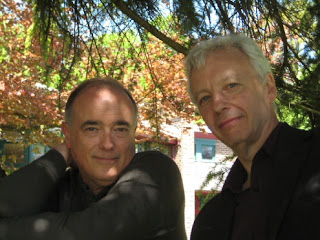 |
| Fretwork - Asako Morikawa, Reiko Ichise, Richard Tunnicliffe, Richard Boothby |
Reviewed by Ruth Hansford on Dec 04 2015
Star rating:
Local connection? Opening concert a Spitalfields highlights the continuity of street cries, yet fails to fully engage
This year’s Spitalfields Winter Festival opened on 4 December 2015 with a concert at St Leonard's Church, Shoreditch, celebrating the area’s rich local heritage. Viol consort Fretwork (Asako Morikawa, Emily Ashton, Sam Stadlen, Richard Tunnicliffe, Richard Boothby) and vocal ensemble Red Byrd (Cecilia Osmond, Harvey Brough, John Potter, James Newby, Richard Wistreich) put together a programme of Cries of London, featuring sixteenth-century street traders’ cries set to music by the leading composers of the day (as well as captured in countless paintings and prints over the centuries).
 |
| John Potter & Richard Wistreich of Red Byrd |
Spitalfields blogger The Gentle Author set the scene in a pre-concert talk, showing how the tradition endures to this day: the One Pound Fish Man of Upton Park is now a YouTube sensation and pop star in Pakistan; Jack Cohen of Tesco fame and Michael Marks (& Spencer) started off as market traders; Lionel Begleiter – later Bart – grew up in a flat on the corner of Brick Lane, and famously incorporated street cries into Oliver! Of course the tradition is also under threat from gentrification, but then it might be argued that the wealthy patrons of the higher-status poets and composers of the sixteenth century were already cynically exploiting this edgy, noisy urban culture for their own genteel – or even patronising – entertainment.
The texts of the various Cries give us a vivid picture of urban life of the time: bumpkins selling fruit and veg, boatmen selling fresh fish, hawkers of clothes and fancy goods and dodgy cures for all manner of ailments, as well as offers from chimney sweeps, wood choppers, rat catchers and repairers of bellows. The women who figure in these songs were predominantly innocent milkmaids or fallen women. The food on sale would find its place in today’s trendy farmers’ markets: oysters (in fact lots of fish), samphire, hot pies, sausage and fresh cheeses. Flirting was, as now, a crucial part of the street trader’s toolkit. In the days when the countryside was so close to London, and the sea and rivers were clean and well stocked, people ate well.
The concert opened in surround sound, Cries coming from all parts of the church before the singers assembled on the platform. They sang mostly in rural accents, with broad vowels and postvocalic r’s (London’s population grew five-fold between 1530 and 1605, and the countryside must have been ever present). Tenor John Potter has an impressive array of farmyard noises in his repertoire and soprano Cecilia Osmond played milkmaid and fishwife convincingly.
However, there was a fundamental difficulty: the singers spent much of the evening standing behind the viol consort and their words were masked by the instruments. They sang from the score, oratorio-style, and hardly looked up, let alone interact with us or give us a sense of the earthy, at times filthy, text. The resonant acoustic of St Leonard’s church didn’t help with comprehensibility and the audience had to read from the printed programme to get any sense of what was going on. Nobody seemed to have checked the balance in the rehearsal. Only one of the singers, baritone Harvey Brough, had managed to find something approaching a costume in his dressing up box. We all fared better when singers were in front of the band, but it was surprising that such an experienced ensemble would not have taken into account the acoustics of the space. It could have been a much more engaging show, if only we had heard some consonants.
The instrumental interludes gave us a break from reading. These were the most successful part of the evening – beautifully still and contemplative, with melismatic lines weaving around each other. This worked well in the space.
Reviewed by Ruth Hansford
Elsewhere on this blog:
- Beyond Nine Lessons and Carols: My Christmas disc roundup - CD review
- Italian realist: Cav and Pag at Covent Garden - opera review
- Late night Piazzolla: Tango Embrace - CD review
- Inspired by Goethe: Dorottya Lang & Helmut Deutsch - concert review
- Unjustly neglected: Elizabeth Watts in arias by Alessandro Scarlatti - CD review
- Challenging yet fascinating: Haas Morgen und Abend - opera review
- Cool & atmospheric: Christiane Karg & Graham Johnson in Schubert - concert review
- Capturing hearts: Ermonela Jaho as Leoncavallo's Zaza with Opera Rara - opera review
- Deft lightness: Gounod's La Colombe - Cd review
- Thomas Tallis: Chronology, Contexts, Discoveries conference at Sidney Sussex College - conference report
- Birthday treats: Roderick Williams & Florilegium at the Wigmore Hall - concert review
- Schubert, Beethoven, Mozart, Spohr: Der Hirt auf dem Felsen - concert review
- Schubert, Chopin, Brahms, Schumann: Der Hirt auf dem Felsen - CD review
- Home










%20as%20Leporello%20and%20Erik%20Tofte%20(back%20to%20camera%20in%20garnet%20shirt)%20as%20Giovanni%20-%20Don%20Giovanni.jpg)
No comments:
Post a Comment